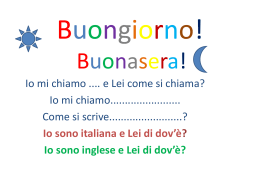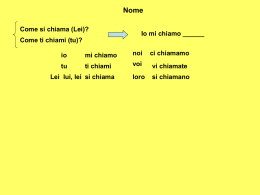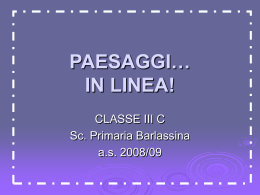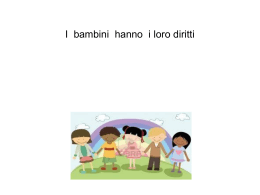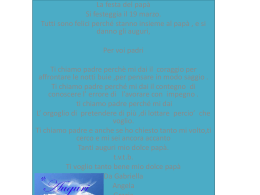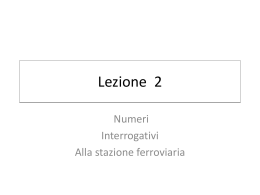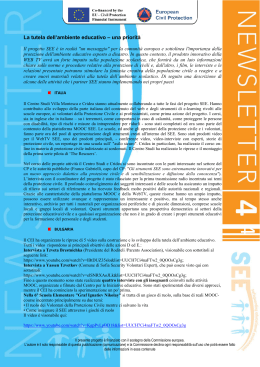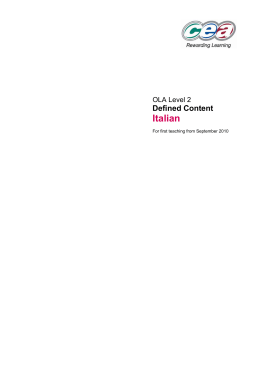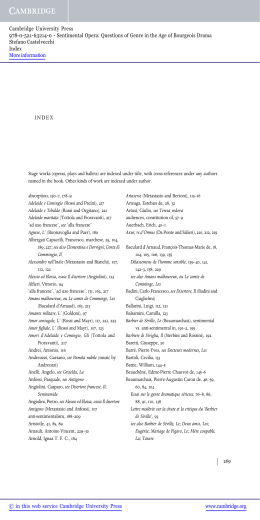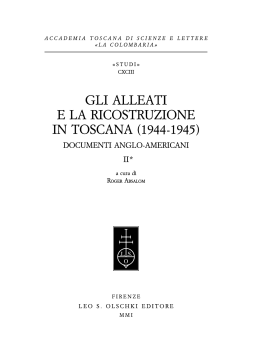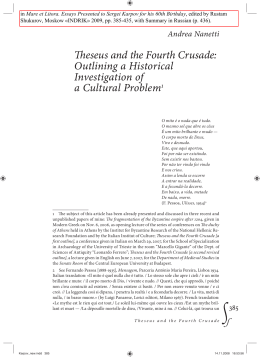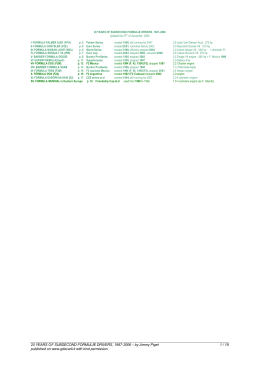LESSON 1 PRESENTAZIONI (INTRODUCTIONS) BENVENUTI! (Welcome!) “You live a new life for every new language you speak. If you know only one language, you live only once.” Czech proverb 2 Buongiorno! Mi chiamo Mary Hammond. Sono la vostra professoressa d’italiano. e Lei, come si chiama? IL NOSTRO SCOPO (our goal) CONFIDENCE COMPREHENSION CULTURAL AWARENESS … e Lei come si chiama? And what is your name? • Buongiorno, Signora. Mi chiamo Laura Dini. My name is... …e Lei, come si chiama? And what’s your name? • Mi chiamo Anna Smith. Piacere! Nice to meet you! LA LINGUA ITALIANA L’ALFABETO L’ALFABETO: 21 lettere a a f effe l elle p pi t ti b bi g gi m emme q cu u u c ci h acca n enne r erre v vu d di i i o o s esse z zeta e e j i lunga k cappa w vu doppia x ics y i greca I VOCALI i o u a e = = = = = MACHINE DOG BLUE PAPA BED LA LINGUA ITALIANA LA LINGUA ITALIANA PRONUNCIA PRONUNCIA C / G / GLI / GN C&G Soft Sound: ce = cello ci = cinque ge = gelato gi = Gina Hard Sound: carta gatto come agosto cultura gusto GLI & GN • Gli is prounced like the English lli in million • luglio • famiglia • Gn is similar to the English ny in canyon • lasagne • gnocchi LA PRONUNCIA L’ACCENTO TONICO • Stress on the next-to-the-last syllable (most common): – studentessa – lavagna – capito – parlare – studiare • Stress on the last vowel (written accent) : – città – università – nazionalità – caffè – tiramisù LA LINGUA ITALIANA L’ALFABETO LO SPELLING a Ancona f Firenze l Livorno p Perugia t Torino b Bologna g Genova m Milano q quadro u Udine c Caserta h hotel n Napoli r Roma v Venezia d Domodossola i Imola o Otranto s Siena z Zara e Empoli j jeans k kappa w Washingt on x xilofono y York ESPRESSIONI UTILI (1) • • • • • • • Non capisco. Non lo so. Che significa …? Come si dice … ? Come si pronuncia ? Come si scrive … ? Ripeta, per favore. • • • • • • • I don’t understand. I don’t know. What does … mean? How do you say …? How do you pronounce? How do you write …? Please repeat. ESPRESSIONI UTILI (2) in classe Ascoltate! Listen! Leggete. Read. Ripetete dopo di me. Repeat after me. Capite? / Capito! Do you understand? / Got it! Bene! Benissimo! Well done! Great! ESPRESSIONI UTILI See if you can say in Italian… 1. How do you say …? 2. I don’t know. 3. I don’t understand. 4. What does … mean? 5. Please repeat. ESPRESSIONI di CORTESIA • • • • • • Excuse me. Please. Thank you. You’re welcome! May I? You’re very kind. • • • • • • Scusi. Per favore. Grazie. Prego! Posso? Lei è molto gentile. ESPRESSIONI di CORTESIA • • • • • • Excuse me. Please. Thank you. You’re welcome! May I? You’re very kind. • • • • • • Scusi. Per favore. Grazie. Prego! Posso? Lei è molto gentile. Lei or tu? Most of your interactions with Italians will be conducted using the formal verbs and forms of address. You will use the pronoun Lei to mean “you”. Ex: Come si chiama Lei? With friends, children and anyone with whom you are on a first-name basis, you may use the more familiar pronoun tu to mean “you”. Ex: Come ti chiami tu? ADDRESSING PEOPLE SALUTI FORMAL (Greetings) FAMILIAR AND FORMAL FAMILIAR Salve! Ciao! Hello! Buongiorno! Good morning! Buonasera! Good evening! ArrivederLa! Arrivederci! Ciao! Good bye! A presto! See you soon! A dopo! / A piu tardi! See you later! A domani! See you tomorrow! Come va? How is it going? • Buonasera, Signorina! • Salve, Signore! Come va? • Bene! [Non c’è male. Abbastanza bene. Cosìcosì.] • Grazie. E Lei, come sta? • Sto bene, grazie. • Arrivederci! Conversazione FORMALE • Good evening, Miss! • Hello, Sir! How are you? • Fine! (Not bad. Pretty good. So-so.) • Thank you. And how are you? • I’m doing well, thanks. • See you! Di dov’è? • Signora Brindi, di dov’è? • Mrs. Brindi, where are you from? • Sono di Firenze. Sono italiana. E Lei, Signor Grant, di dov’è? • I am from Florence. I am Italian. And you, Mr. Grant, where are you from? • Sono di Chicago. Sono americano. • I am from Chicago. I am American. Conversazione FORMALE Conversazione In pairs act out the following dialogue. For each question you ask, your partner answers and then asks the same question to you. Example: Ask your partner what his/her name is. A: Come si chiama? B: Mi chiamo Anna Smith. E Lei, come si chiama? A: Mi chiamo John Jenkins. Piacere! 1. 2. 3. 4. Greet your partner. Ask what his/her name is. Ask him/her how he/she is. Ask him/her where he/she is from. Conversazione FORMALE per la prossima (for the next time) numeri (numbers) nazionalità (nationalities) vocabolario: all’aeroporto (at the airport)
Scarica
